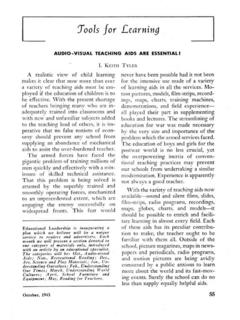Transcription of CHAPTER 2 NOT FOR SALE OR DISTRIBUTION Leadership …
1 Blackdovfx/iStock/Thinkstock Leadership Theory and Application for Nurse Leaders Linda Roussel , Patricia L. Thomas , and Carol Ratcliffe LEARNING OBJECTIVES 1. Describe how Leadership theory underpins healthcare management. 2. Discuss the guiding principles and competencies for nursing Leadership practice. 3. Relate selected theories of Leadership and management to organizational outcomes. 4. Discuss the role of nursing Leadership in managing a clinical discipline. AONE KEY COMPETENCIES I. Communication and relationship building II.
2 Knowledge of the healthcare environment III. Leadership IV. Professionalism V. Business skills AONE KEY COMPETENCIES DISCUSSED IN THIS CHAPTER III. Leadership IV. Professionalism III. Leadership Foundational thinking skills Personal journey disciplines Ability to use systems thinking Succession planning Change management IV. Professionalism Personal and professional accountability Career planning Ethics Evidence-based clinical and management practices CHAPTER 2 2502/07/15 12:14 pm Jones & Bartlett Learning, LLC.
3 NOT FOR SALE OR DISTRIBUTION . 2285 Jones & Bartlett Learning, LLCNOT FOR SALE OR DISTRIBUTION Jones & Bartlett Learning, LLCNOT FOR SALE OR DISTRIBUTION Jones & Bartlett Learning, LLCNOT FOR SALE OR DISTRIBUTION Jones & Bartlett Learning, LLCNOT FOR SALE OR DISTRIBUTION Jones & Bartlett Learning, LLCNOT FOR SALE OR DISTRIBUTION Jones & Bartlett Learning, LLCNOT FOR SALE OR DISTRIBUTION Jones & Bartlett Learning, LLCNOT FOR SALE OR DISTRIBUTION Jones & Bartlett Learning, LLCNOT FOR SALE OR DISTRIBUTION Jones & Bartlett Learning, LLCNOT FOR SALE OR DISTRIBUTION Jones & Bartlett Learning, LLCNOT FOR SALE OR DISTRIBUTION Jones & Bartlett Learning, LLCNOT FOR SALE OR DISTRIBUTION Jones & Bartlett Learning, LLCNOT FOR SALE OR DISTRIBUTION Jones & Bartlett Learning, LLCNOT FOR SALE OR DISTRIBUTION Jones & Bartlett Learning, LLCNOT FOR SALE OR DISTRIBUTION Jones & Bartlett Learning, LLCNOT FOR SALE OR DISTRIBUTION Jones & Bartlett Learning, LLCNOT FOR SALE OR DISTRIBUTION Jones & Bartlett Learning, LLCNOT FOR SALE OR DISTRIBUTION Jones & Bartlett Learning.
4 LLCNOT FOR SALE OR DISTRIBUTION Jones & Bartlett Learning, LLCNOT FOR SALE OR DISTRIBUTION Jones & Bartlett Learning, LLCNOT FOR SALE OR DISTRIBUTION Advocacy for the clinical enterprise and for nursing practice Active membership in professional organizations FUTURE OF NURSING: FOUR KEY MESSAGES 1. Nurses should practice to the full extent of their education and training. 2. Nurses should achieve higher levels of education and training through an improved education system that promotes seamless academic progression.
5 3. Nurses should be full partners with physicians and other health profession-als in redesigning health care in the United States. 4. Effective workforce planning and policy making require better data collec-tion and information infrastructure. Introduction Leadership counts, and leading like it matters is essential for inspiring and engag-ing our constituents, colleagues, and stakeholders. Without a spirited and deeply satisfied workforce, sustained safety and quality care are improbable. Gallup s State of the American Workplace report (2013) said a staggering 70% of Americans have negative feelings about their work.
6 Some of the following findings were noted: Only 30% of employees are engaged and inspired at work. About 52% of employees are present but not engaged. A full 18% are actively disengaged or worse. As much as $550 billion in productivity is lost because of the 18% of actively disengaged employees. This CHAPTER focuses on Leadership theories and models and their application to administrative practices. How leaders impact workforce and patient outcomes serves as the impetus for ongoing improvements and innovations. WHAT DO LEADERS DO?
7 Kotter (2014) notes that management and Leadership are different. Specifically, he notes the following: Management involves planning and budgeting. Leadership involves setting a direction. Management involves organizing and staffing. Leadership involves aligning people. Management provides control and solves problems. Leadership provides motivation and inspiration. Gardner (1993) asserts that first-class managers are usually first-class leaders. Leaders and leader managers distinguish themselves beyond run-of-the-mill managers in six respects: They think longer term beyond the day s crises, beyond the quarterly report, beyond the horizon.
8 26 CHAPTER 2 Leadership Theory and Application for Nurse 2602/07/15 12:14 pm Jones & Bartlett Learning, LLC. NOT FOR SALE OR DISTRIBUTION . 2285 Jones & Bartlett Learning, LLCNOT FOR SALE OR DISTRIBUTION Jones & Bartlett Learning, LLCNOT FOR SALE OR DISTRIBUTION Jones & Bartlett Learning, LLCNOT FOR SALE OR DISTRIBUTION Jones & Bartlett Learning, LLCNOT FOR SALE OR DISTRIBUTION Jones & Bartlett Learning, LLCNOT FOR SALE OR DISTRIBUTION Jones & Bartlett Learning, LLCNOT FOR SALE OR DISTRIBUTION Jones & Bartlett Learning, LLCNOT FOR SALE OR DISTRIBUTION Jones & Bartlett Learning, LLCNOT FOR SALE OR DISTRIBUTION Jones & Bartlett Learning.
9 LLCNOT FOR SALE OR DISTRIBUTION Jones & Bartlett Learning, LLCNOT FOR SALE OR DISTRIBUTION Jones & Bartlett Learning, LLCNOT FOR SALE OR DISTRIBUTION Jones & Bartlett Learning, LLCNOT FOR SALE OR DISTRIBUTION Jones & Bartlett Learning, LLCNOT FOR SALE OR DISTRIBUTION Jones & Bartlett Learning, LLCNOT FOR SALE OR DISTRIBUTION Jones & Bartlett Learning, LLCNOT FOR SALE OR DISTRIBUTION Jones & Bartlett Learning, LLCNOT FOR SALE OR DISTRIBUTION Jones & Bartlett Learning, LLCNOT FOR SALE OR DISTRIBUTION Jones & Bartlett Learning, LLCNOT FOR SALE OR DISTRIBUTION Jones & Bartlett Learning, LLCNOT FOR SALE OR DISTRIBUTION Jones & Bartlett Learning, LLCNOT FOR SALE OR DISTRIBUTION They look beyond the unit they head and grasp its relationship to larger realities, such as the larger organization of which they are a part, conditions external to the organization, and global trends.
10 They reach and influence constituents beyond their jurisdiction and beyond boundaries. Thomas Jefferson influenced people all over Europe. Gandhi influenced people all over the world. In an organization, leaders overflow bureaucratic boundaries, which is often a distinct advantage in a world that is too complex and tumultuous to be handled through channels. Their capacity to rise above jurisdictions may enable them to bind together the fragmented constituencies that must work together to solve a problem. They put heavy emphasis on the intangibles of vision, values, and motiva-tion and intuitively understand the nonrational and unconscious elements in the leader constituent interaction.
















